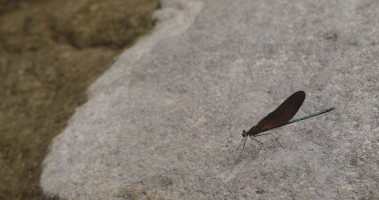We have all heard the statement that we need a cold winter to reduce the bug population in the spring. This is true to some extent. As you probably expected, many insects do indeed perish when cold weather strikes. This fate isn’t as harsh as it sounds, though.
Most of these have already completed their true mission in life which is to reproduce. These insects often spend their last days preparing the next generation for the upcoming spring. They do so by laying eggs in sheltered  areas or providing their larvae with food and shelter to survive the winter, often at the expense of their own well-being. One good example is the field cricket. Adults (and immature nymphs) can't survive cold, winter temperatures.
areas or providing their larvae with food and shelter to survive the winter, often at the expense of their own well-being. One good example is the field cricket. Adults (and immature nymphs) can't survive cold, winter temperatures.
Their eggs, however, overwinter and will hatch in the spring, bringing forth a new generation of these pests. As far as weather goes, temperature is not as important to early insect populations as the amount of moisture. Very dry conditions are especially harmful to insects and will depress their populations more than cold temperatures. Many different insects live in the soil, and they depend on soil moisture to survive. Additionally, a drought will reduce the amount of plant biomass available as food for herbivorous insects. 
Some insects, Monarch Butterflies are a prime example, outrun the cold weather by migrating away from it. These insects usually engage in a one-way migration to warmer climates to the south where they reproduce, die and send a new generation northward to begin the cycle again. Other insects, such as dragonflies, engage in a less direct migration. Their daily activities continuously move them toward warmer climates, and the insects never really experience prolonged cold weather. Instead, these insect populations cycle north and south each year. A few insects, particularly those with habitats in extreme latitudes, have developed the ability to survive ice formation within their tissues. They survive thanks to a natural anti-freeze they can create. This anti-freeze prevents the formation of damaging ice crystals and allows the insect to survive until they thaw.
The famed woolly bear moth caterpillar and their arctic kin are well-known for their survival with the help of  anti-freeze. Probably the most popular cold-temperature defense mechanism of the insect world is freeze avoidance, which is a fancy term for “hunkering down for the winter.” One of the most common strategies is to bury themselves underground, beneath leaf litter, or to burrow under tree bark for protection and hibernate for the season. For these animals, plant debris on a forest floor is as cozy as curling up under a blanket to watch the snow fall outside. And speaking of snow, that just adds another layer of insulation to bugs like ticks that burrow underground for heat when the temperature drops outside. These protective maneuvers work pretty well most winters, allowing insect populations to remain relatively stable.
anti-freeze. Probably the most popular cold-temperature defense mechanism of the insect world is freeze avoidance, which is a fancy term for “hunkering down for the winter.” One of the most common strategies is to bury themselves underground, beneath leaf litter, or to burrow under tree bark for protection and hibernate for the season. For these animals, plant debris on a forest floor is as cozy as curling up under a blanket to watch the snow fall outside. And speaking of snow, that just adds another layer of insulation to bugs like ticks that burrow underground for heat when the temperature drops outside. These protective maneuvers work pretty well most winters, allowing insect populations to remain relatively stable.
A recent spate of warmer than average winters over the last few decades, however, has allowed the populations of some types of creepy crawlies to explode. When winter temperatures never reach a truly deep freeze, bugs make it through to spring unscathed and ready to multiply. For instance, Lyme-disease-carrying deer ticks — which are not actually insects, but eight-legged arachnids, like spiders — are now seen in larger quantities and have spread farther to the north than they once roamed. When temperatures drop well below 0° F, though, many individual insects die. The colder the temperature becomes, the fewer survive.
and ready to multiply. For instance, Lyme-disease-carrying deer ticks — which are not actually insects, but eight-legged arachnids, like spiders — are now seen in larger quantities and have spread farther to the north than they once roamed. When temperatures drop well below 0° F, though, many individual insects die. The colder the temperature becomes, the fewer survive.
So this is one reason to be thankful for the dry and extreme cold but snowless conditions we have been going through. It has probably helped reduce the bug populations some already. If you're a gardener, tree-hugger, or just someone who wants to see flowers, trees, shrubs and crops thrive this spring, go ahead, join the entomologists in hoping for another, even colder, polar vortex to settle over the country this winter. If you enjoy reading this blog, feel free to comment and please hit the like button at the bottom.






